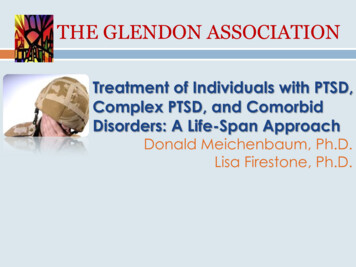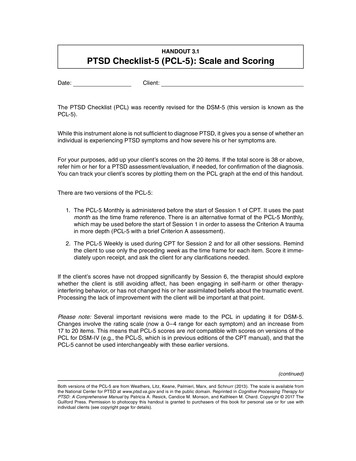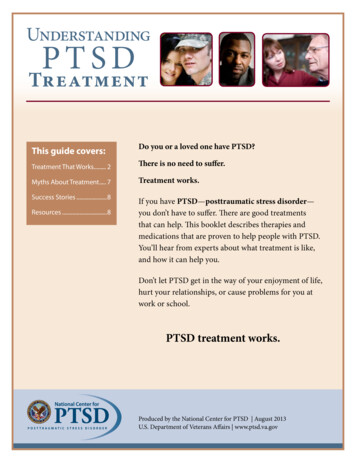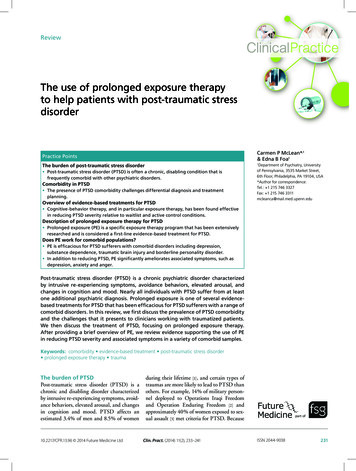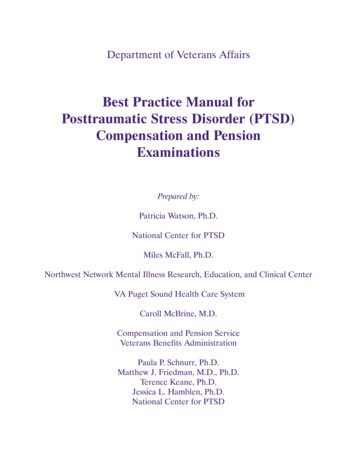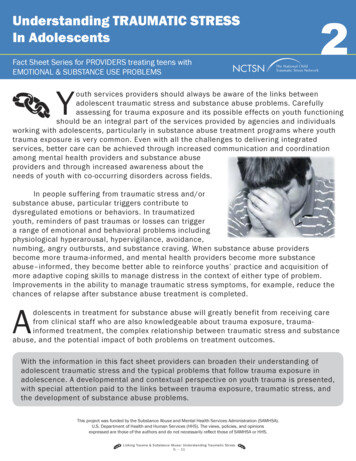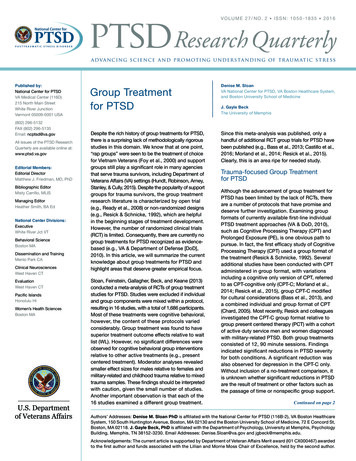
Transcription
V O L U M E 2 7 / N O . 2 I S S N : 1 0 5 0 -1 8 3 5 2 0 1 6Research Quarterlyadvancing science and pr omoting unders tanding of traum atic stressPublished by:National Center for PTSDVA Medical Center (116D)215 North Main StreetWhite River JunctionVermont 05009-0001 USA(802) 296-5132FAX (802) 296-5135Email: ncptsd@va.govAll issues of the PTSD ResearchQuarterly are available online at:www.ptsd.va.govEditorial Members:Editorial DirectorMatthew J. Friedman, MD, PhDBibliographic EditorMisty Carrillo, MLISManaging EditorHeather Smith, BA EdNational Center Divisions:ExecutiveWhite River Jct VTBehavioral ScienceBoston MADissemination and TrainingMenlo Park CAClinical NeurosciencesWest Haven CTEvaluationWest Haven CTPacific IslandsHonolulu HIWomen’s Health SciencesBoston MAGroup Treatmentfor PTSDDespite the rich history of group treatments for PTSD,there is a surprising lack of methodologically rigorousstudies in this domain. We know that at one point,“rap groups” were seen to be the treatment of choicefor Vietnam Veterans (Foy et al., 2000) and supportgroups still play a significant role in many agenciesthat serve trauma survivors, including Department ofVeterans Affairs (VA) settings (Hundt, Robinson, Arney,Stanley, & Cully, 2015). Despite the popularity of supportgroups for trauma survivors, the group treatmentresearch literature is characterized by open trial(e.g., Ready et al., 2008) or non-randomized designs(e.g., Resick & Schnicke, 1992), which are helpfulin the beginning stages of treatment development.However, the number of randomized clinical trials(RCT) is limited. Consequently, there are currently nogroup treatments for PTSD recognized as evidencebased (e.g., VA & Department of Defense [DoD],2010). In this article, we will summarize the currentknowledge about group treatments for PTSD andhighlight areas that deserve greater empirical focus.Sloan, Feinstein, Gallagher, Beck, and Keane (2013)conducted a meta-analysis of RCTs of group treatmentstudies for PTSD. Studies were excluded if individualand group components were mixed within a protocol,resulting in 16 studies, with a total of 1,686 participants.Most of these treatments were cognitive behavioral,however, the content of these protocols variedconsiderably. Group treatment was found to havesuperior treatment outcome effects relative to waitlist (WL). However, no significant differences wereobserved for cognitive behavioral group interventionsrelative to other active treatments (e.g., presentcentered treatment). Moderator analyses revealedsmaller effect sizes for males relative to females andmilitary-related and childhood trauma relative to mixedtrauma samples. These findings should be interpretedwith caution, given the small number of studies.Another important observation is that each of the16 studies examined a different group treatment.Denise M. SloanVA National Center for PTSD, VA Boston Healthcare System,and Boston University School of MedicineJ. Gayle BeckThe University of MemphisSince this meta-analysis was published, only ahandful of additional RCT group trials for PTSD havebeen published (e.g., Bass et al., 2013; Castillo et al.,2016; Morland et al., 2014; Resick et al., 2015).Clearly, this is an area ripe for needed study.Trauma-focused Group Treatmentfor PTSDAlthough the advancement of group treatment forPTSD has been limited by the lack of RCTs, thereare a number of protocols that have promise anddeserve further investigation. Examining groupformats of currently available first-line individualPTSD treatment approaches (VA & DoD, 2010),such as Cognitive Processing Therapy (CPT) andProlonged Exposure (PE), is one obvious path topursue. In fact, the first efficacy study of CognitiveProcessing Therapy (CPT) used a group format ofthe treatment (Resick & Schnicke, 1992). Severaladditional studies have been conducted with CPTadministered in group format, with variationsincluding a cognitive only version of CPT, referredto as CPT-cognitive only (CPT-C; Morland et al.,2014; Resick et al., 2015), group CPT-C modifiedfor cultural considerations (Bass et al., 2013), anda combined individual and group format of CPT(Chard, 2005). Most recently, Resick and colleaguesinvestigated the CPT-C group format relative togroup present centered therapy (PCT) with a cohortof active duty service men and women diagnosedwith military-related PTSD. Both group treatmentsconsisted of 12, 90 minute sessions. Findingsindicated significant reductions in PTSD severityfor both conditions. A significant reduction wasalso observed for depression in the CPT-C only.Without inclusion of a no-treatment comparison, itis unknown whether significant reductions in PTSDare the result of treatment or other factors such asthe passage of time or nonspecific group support.Continued on page 2Authors’ Addresses: Denise M. Sloan PhD is affiliated with the National Center for PTSD (116B-2), VA Boston HealthcareSystem, 150 South Huntington Avenue, Boston, MA 02130 and the Boston University School of Medicine, 72 E Concord St,Boston, MA 02118. J. Gayle Beck, PhD is affiliated with the Department of Psychology, University at Memphis, PsychologyBuilding, Memphis, TN 38152-3230. Email Addresses: Denise.Sloan@va.gov and jgbeck@memphis.edu.Acknowledgements: The current article is supported by Department of Veteran Affairs Merit award (I01 CX000467) awardedto the first author and funds associated with the Lillian and Morrie Moss Chair of Excellence, held by the second author.
Continued from coverIt should be noted that the group format of PCT has been found tobe a moderately efficacious treatment in several group trial studies(Classen et al., 2011; Schnurr et al., 2003) and superior to a notreatment comparison condition (Classen et al., 2011). Thus, thelimited number of studies using group formats of the first linePTSD treatments, combined with a lack of a no treatment comparison,limits interpretation of the Resick et al. (2015) findings.Chard (2005) used a different approach to delivering CPT in a groupformat. In a study of women survivors of childhood sexual assault,Chard adapted the CPT protocol to include 27 sessions of group(17) and individual (9) sessions. Individual sessions were devoted tospecifics of the individual event, including the trauma impact statementand trauma narratives. Group sessions were used to reinforce skillsand concepts introduced in the individual sessions and to foster socialbonds with other group members. Findings indicated significantlygreater reductions of PTSD symptoms for the adapted CPT conditionrelative to a minimal attention (MA) comparison condition. Moreover,treatment gains for the adapted CPT condition were maintained ata one year follow-up. Given the various formats of group CPT thathave been investigated, it is unclear at this time which format is thebest to pursue for additional development.Although there is a large literature demonstrating the efficacy andeffectiveness of Prolonged Exposure (PE) therapy, there are no currentstudies investigating a group format of PE. Exposure is thought to bea critical component to effective PTSD treatment (e.g., Institute ofMedicine, 2008), so inclusion of exposure within group treatment forPTSD is important. There is debate, however, about whether conductingtrauma exposure within the group setting (rather than individually) isproblematic, owing to vicarious traumatization of other members.There have been a number of group protocols that have used variousapproaches to conducting imaginal and/or in vivo exposures in thecontext of treatment. For example, Schnurr et al. (2003) examinedthe efficacy of a trauma-focused group treatment (TFGT) comparedto group PCT for military-related PTSD. Both treatment conditionsinvolved 30 weekly sessions lasting 90 minutes, although sessionsthat included exposure lasted two hours. Imaginal exposure wasconducted within the group by Veterans taking turns recounting theirtrauma event while other members listened. Each Veteran had twosessions devoted to recounting their trauma event, with imaginalexposure sessions starting in session 9 through session 22. In vivoexposure was not included in the protocol. The time needed to conductimaginal exposure within the group for each group member wasextensive and may reduce the potential cost-effectiveness of thegroup format. Schnurr et al. attempted to make up for the limited timefor in-session exposure through daily homework utilizing audiotapes.Findings indicated both groups had significant reductions in PTSDsymptoms, with no between treatment differences. Significant betweentreatment differences were only observed for participants whocompleted treatment, with significantly greater reductions in TFGTrelative to group PCT. Notably, treatment dropout was substantiallyhigher in the TFGT (23%) relative to group PCT (9%). Althoughinformation was not collected regarding reasons for dropout,participants may have found exposures conducted in-sessiondifficult to tolerate.Ready and colleagues (2008) also conducted exposure in-session byadapting the approach used by Schnurr et al. (2003). In an open trial,these investigators examined the efficacy of group based exposurePAGE 2therapy (GBET) among 102 Veterans. The group protocol consistedof 3 hours of treatment twice a week for 16-18 weeks. A minimum of60 hours of exposure was included (3 hours of within group exposureper Veteran, 30 hours of listening to recordings of imaginal exposure,and 27 hours of hearing other Veterans’ trauma accounts). Significantreductions in PTSD severity were observed. Notably, only three peopledropped out of the group prematurely suggesting that the in-sessionexposures were well tolerated. It should be stated that the protocolincluded group members having lunch together, which likely facilitatedgroup cohesion.Castillo et al. (2016) used a similar approach to conducting imaginalexposure. In this study, group treatment consisted of 90 minute,16 weekly sessions with only three women Veterans per group.Participants first completed a trauma narrative as homework. EachVeteran received four sessions of imaginal exposure, in which theyread their narrative out loud in the group session. The protocol alsoincluded cognitive and skills components. The group size was limitedto three members to permit the increased dose of imaginal exposureconducted in session. Relative to a WL comparison, participantsin the trauma-focused group had significant reductions in PTSDseverity at post-treatment, with treatment gains maintained at6 month follow-up. This protocol differs from Schnurr et al. (2003)and Ready et al. (2008) with a less time treatment protocol.Treatment dropout rate was 24%.Beck, Coffey, Foy, Keane, and Blanchard (2009) used a differentapproach to conducting exposure treatment in the group context.Rather than have group members recount their trauma accounts outloud in-session, group members are instructed to write their traumanarrative during session. The trauma narratives are conducted in twosessions. This approach has the advantage of efficient use of time asall group members are conducting imaginal exposure simultaneously.The approach also reduces the risk of triggering responses amongfellow group members. In addition, the protocol, referred to as groupcognitive behavioral treatment (GCBT), includes in vivo exposuresconducted between sessions as homework. The protocol consists of14, 2-hour sessions. Beck et al. found significant reductions in PTSDseverity for GCBT relative to WL with a sample of adults who hadmotor vehicle-related PTSD. Treatment dropout rate was 27%.A study is currently underway to investigate the efficacy of GCBTrelative to group PCT in a sample of Veterans diagnosed withPTSD (Sloan, Unger, & Beck, 2016).Taking a similar approach to Chard (2005), Beidel, Frueh, Uhde,Wong, and Mentrikoski (2011) used a combination of groupand individual treatment. This protocol, referred to as TraumaManagement Therapy (TMT), combines exposure therapy and socialemotional rehabilitation. The exposure component is conducted inthe individual sessions, whereas the social emotional rehabilitation isconducted using the group format. TMT is based on strong empiricalevidence favoring exposure therapy delivered individually, which itcombines with group treatment to address social functioning,thereby providing a more comprehensive approach. In a sampleof 35 Veterans who were randomly assigned to TMT or exposuretherapy without group treatment, both conditions displayedsignificant reductions in PTSD with no between-group differences.As anticipated, the TMT condition had greater improvements insocial functioning relative to exposure only. Treatment dropout forTMT was 22% relative to 6% in exposure only.P T S D R E S E A R C H Q U A R T E R LY
The higher dropout rate in TMT may be due to the greater timecommitment involved in this treatment relative to the exposure onlycondition. Although replication is needed, this approach may beparticularly appealing to trauma survivors who have deficits insocial functioning.To summarize, protocols for group treatment for PTSD have useddifferent approaches to conduct exposure thought to be critical tosuccessful treatment. Two studies have used a combined group andindividual format (Beidel et al., 2011; Chard, 2005), whereas moststudies have incorporated exposure-based techniques in the groupcontext. However, the format used for imaginal exposure has varied,with most protocols asking group members to recount their traumamemory out loud while other group members listen. In contrast,Beck and colleagues (2009) had group members write their traumaaccount during session. Beck et al. and Castillo et al. (2016) also hada lower treatment dose than other treatments (Ready et al., 2008;Schnurr et al., 2003). Despite the dose differences, large withingroup effect sizes were observed for PTSD symptom reduction andsimilar treatment dropout rates were reported across the studies.Thus, no single protocol appears superior to another in terms ofoutcome effects. The protocols used by Schnurr et al. (2003) andReady et al. (2008) are fairly time intensive. Similarly, the time requiredfor protocols that use a combination of individual and group formatsis greater than the protocols used by Castillo et al. and Beck et al.Given the data reported so far, it may be most cost effective to use agroup treatment that involves less time.Group Protocols that Address Comorbid ConditionsDespite these promising findings for interpersonal therapy, there havebeen no additional studies of the efficacy of interpersonal grouptherapy for PTSD. Further investigation should be pursued in whicha treatment comparison condition is included.Seeking Safety (SS) is a well-known group treatment that targetsa common comorbid condition in PTSD, substance use disorder.This treatment is a present-focused, coping skills approach thatincludes skills in distress tolerance and affect management.SS is frequently used in VA healthcare settings, yet efficacy findingsfor this treatment have been mixed. Early studies consisted of eitheran open trial design or a no treatment comparison condition.Findings from these studies demonstrated that SS reduces PTSDsymptoms as well as substance use (for a review see, Najavits & Hein,2013). However, more recent RCTs that have included an activetreatment comparison condition (e.g., psychoeducation or treatmentas usual), find significant within group effects for all treatmentgroups but no significant between group effects (Hien et al., 2009;Zlotnick, Johnson, & Najavits, 2009). It should also be noted thatacross studies, the effect sizes for PTSD symptom reduction tendto be larger than what has been observed for substance use, whichmay indicate that substance use is more difficult to treat (Najavits& Hien, 2013). Taken together, the findings to date do not indicatethat SS is superior to other active group treatments, includingpsychoeducation. The continued popularity of SS may reflect theneed for a treatment protocol that addresses PTSD and comorbidsubstance use combined as well as the limited availability ofsuch protocols.Comorbid psychiatric conditions are common in PTSD, thus a numberof group treatments have been developed to target comorbid conditions.One such example is Dunn and colleagues (2007) who tested theefficacy of self-management group treatment among a sample of101 male Veterans diagnosed with chronic PTSD and depression.Self-management group therapy is designed to target depression andincludes self-monitoring of positive activities and daily mood, goalsetting and self-reinforcement for gains. Relative to a psychoeducationgroup treatment, Veterans assigned to self-management therapyshowed a small reduction in depression symptoms at post-treatment.However, this reduction was no longer observed at the follow-upassessment. Moreover, no between group treatment differenceswere observed for PTSD outcome. It should also be noted that 33%of participants assigned to self-management group dropped outprematurely compared with 12% in the psychoeducation group.Human immunodeficiency virus (HIV) is another important comorbidcondition among trauma survivors for which group treatment protocolshave been developed. The rate of PTSD among individuals who areHIV positive is significantly higher than among the general populationand those with PTSD tend to be less adherent to antiretroviral regimes,which can have fatal consequences (Beckerman & Auerbach, 2010).Thus, treatment of PTSD among HIV positive individuals is an importantarea to address. Sikkema et al. (2007) investigated the efficacy of agroup treatment protocol designed to address trauma symptomsstemming from childhood sexual abuse among 202 HIV positiveadults. The 15-session treatment uses a cognitive-behavioral modelto address coping strategies for both sexual trauma and HIV infection.Significant reductions in PTSD symptoms were observed for thetrauma and HIV coping treatment relative to a support group and aWL comparison conditions. No group differences were observedbetween the support group and the WL condition.Another approach to treating comorbid depression among individualswith PTSD is interpersonal therapy, which has been found to beefficacious in the treatment of depression. In an open trial study, Rayand Webster (2010) found significant reductions in PTSD and depressionsymptoms as well as improvements in interpersonal functioning followingan interpersonal group treatment among a small sample of VietnamVeterans. The interpersonal group treatment involved assessingdysfunctional relationship patterns, developing new social contacts,and re-establishing lost relationships. The group consisted of eight,2-hour sessions. Cloitre and Koenen (2001) also found significantimprovements in PTSD and depression symptoms for women whocompleted a 12-week interpersonal process group. However, notreatment gains were observed when groups included one or moremembers who had a diagnosis of borderline personality disorder.In light of considerable comorbidity, efforts to address PTSD in a grouptreatment setting are wise to incorporate therapeutic components thatalso focus on co-occurring psychiatric and physical health problems.As noted, the literature on group treatments targeting two conditionssimultaneously is in its infancy. It is possible that as this literaturegrows, we will have a clearer idea of whether treatments that addresscomorbid conditions are more efficacious, relative to interventionsthat target PTSD alone. While efficacy may be equal between thesetwo types of group treatments, one can wonder whether otherdimensions of difference may appear. For instance, patients mayprefer group treatments that target both PTSD and a co-occurringissue such as depression, as this type of approach may betteraddress their concerns. Similarly, patients may be less likely to dropout of treatment that they believe is addressing their needs.VOLUME 27/NO. 2 2016PAGE 3
Limitations of the Literature and Future DirectionsAs noted, a number of limitations exist in the literature on group PTSDtreatment. It is salient that many forms of group PTSD treatment havebeen developed, each with one, perhaps two, supportive studies.This diversity in treatment protocols and relative lack of supportivedata from independent replications of these studies limits knowledgethat can be gained and has led to the lack of an evidence-basedgroup treatment approach for PTSD (Institute of Medicine, 2008;VA & DoD, 2010). Moreover, many extant studies are under-poweredand fail to consider dependencies among participants. As discussed byBaldwin, Murray, and Shadish (2005), when treatments are conductedin a group, participants within each group share the specific groupenvironment, leading to a lack of independence of observations.Analytic approaches need to account for the group clustering effect,a feature largely missing from the literature (Sloan et al., 2013).Exceptions are clearly present. For example, Schnurr et al. (2003) didtheir analyses by regarding the group as the unit rather than eachpatient as the unit. However, this methodological feature is unusualin this literature, at present. Clearly, the literature on group treatmentof PTSD has room for growth, building on the most promising treatmentapproaches. As this literature evolves, greater attention is needed tomethodological sophistication. Determination of cost-effectivenessand patient acceptability of group treatment would be a welcomedaddition, particularly in comparison to individual approaches.With increased treatment demands and greater attention topatient-centered services, group treatments for PTSD need amore solid empirical foundation.ReferencesDepartment of Veterans Affairs & Department of Defense. (2010).VA/DoD clinical practice guideline for management of post-traumaticstress. Retrieved from /cpgPTSDFULL201011612c.pdfInstitute of Medicine. (2008). Treatment of posttraumatic stressdisorder: An assessment of the evidence. Washington, DC: NationalAcademies Press.FEATURED ARTICLESBaldwin, S. A., Murray, D. M., & Shadish, W. R. (2005). Empiricallysupported treatments or Type I errors? Problems with theanalysis of data from group-administered treatments. Journal ofConsulting and Clinical Psychology, 73, 924-935. doi:10.1037/0022006X.73.5.924 When treatments are administered in groups,clients interact in ways that lead to violations of a key assumptionof most statistical analyses-the assumption of independence ofobservations. The resulting dependencies, when not properlyaccounted for, can increase Type I errors dramatically. Of the33 studies of group-administered treatment on the empiricallysupported treatments list, none appropriately analyzed their data.The current authors provide corrections that can be applied toimproper analyses. After the corrections, only 12.4% to 68.2%of tests that were originally reported as significant remainedsignificant, depending on what assumptions were made abouthow large the dependencies among observations really are.PAGE 4FEATURED ARTICLES continuedOf the 33 studies, 6-19 studies no longer had any significant resultsafter correction. The authors end by providing recommendationsfor researchers planning group-administered treatment research.Bass, J. K., Annan, J., McIvor Murry, S., Kaysen, D., Griffiths, S.,Cetinoglu, T., . . . Bolton, P. A. (2013). Controlled trial of psychotherapyfor Congolese survivors of sexual violence. New England Journalof Medicine, 368, 2182-2191. doi:10.1056/NEJMoa1211853Background: Survivors of sexual violence have high rates of depression,anxiety, and post-traumatic stress disorder (PTSD). Although treatmentfor symptoms related to sexual violence has been shown to be effectivein high-income countries, evidence is lacking in low-income, conflictaffected countries. Methods: In this trial in the Democratic Republicof Congo, we randomly assigned 16 villages to provide cognitiveprocessing therapy (1 individual session and 11 group sessions) orindividual support to female sexual-violence survivors with high levelsof PTSD symptoms and combined depression and anxiety symptoms.One village was excluded owing to concern about the competencyof the psychosocial assistant, resulting in 7 villages that providedtherapy (157 women) and 8 villages that provided individual support(248 women). Assessments of combined depression and anxietysymptoms (average score on the Hopkins Symptom Checklist[range, 0 to 3, with higher scores indicating worse symptoms]),PTSD symptoms (average score on the Harvard Trauma Questionnaire[range, 0 to 3, with higher scores indicating worse symptoms]), andfunctional impairment (average score across 20 tasks [range, 0 to 4,with higher scores indicating greater impairment]) were performed atbaseline, at the end of treatment, and 6 months after treatment ended.Results: A total of 65% of participants in the therapy group and 52%of participants in the individual- support group completed all threeassessments. Mean scores for combined depression and anxietyimproved in the individual-support group (2.2 at baseline, 1.7 at theend of treatment, and 1.5 at 6 months after treatment), but improvementswere significantly greater in the therapy group (2.0 at baseline, 0.8 atthe end of treatment, and 0.7 at 6 months after treatment) (P 0.001for all comparisons). Similar patterns were observed for PTSD andfunctional impairment. At 6 months after treatment, 9% of participantsin the therapy group and 42% of participants in the individual-supportgroup met criteria for probable depression or anxiety (P 0.001),with similar results for PTSD. Conclusions: In this study of sexualviolence survivors in a low-income, conflict-affected country, grouppsychotherapy reduced PTSD symptoms and combined depressionand anxiety symptoms and improved functioning.Beck, J. G., Coffey, S. F., Foy, D. W., Keane, T. M., & Blanchard, E. B.(2009). Group cognitive behavior therapy for chronic posttraumaticstress disorder: An initial randomized pilot study. Behavior Therapy, 40,82-92. doi:10.1016/j.beth.2008.01.003 Individuals with posttraumaticstress disorder (PTSD) related to a serious motor vehicle accidentwere randomly assigned to either group cognitive behavioraltreatment (GCBT) or a minimum contact comparison group (MCC).Compared to the MCC participants (n 16), individuals whocompleted GCBT (n 17) showed significant reductions in PTSDsymptoms, whether assessed using clinical interview or a self-reportmeasure. Among treatment completers, 88.3% of GCBT participantsdid not satisfy criteria for PTSD at posttreatment assessment,relative to 31.3% of the MCC participants. Examination of anxiety,depression, and pain measures did not show a unique advantageof GCBT. Treatment-related gains were maintained over a 3-monthP T S D R E S E A R C H Q U A R T E R LY
FEATURED ARTICLES continuedfollow-up interval. Patients reported satisfaction with GCBT, andattrition from this treatment was comparable with individuallyadministered CBTs. Results are discussed in light of modificationsnecessitated by the group treatment format, with suggestions forfuture study of this group intervention.Beckerman, N. L., & Auerbach, C. (2010). Post-traumatic stressdisorder and HIV: A snapshot of co-occurrence. Social Work inHealth Care, 49, 687-702. doi:10.1080/00981389.2010.485089Although the medical advances in the area of human immunodeficiencyvirus (HIV)/acquired immune deficiency syndrome (AIDS) haveundoubtedly improved the length and quality of life for those whoare HIV-affected and medication adherent, there are still manypsychosocial obstacles to effective HIV/AIDS medication adherence.Recent research has focused on one such obstacle. The significantlink between post-traumatic stress disorder (PTSD) and HIV. Thisarticle reports on the nature of this relationship with a cross-sectionalstudy of active clients (n 186) who were receiving HIV servicesfrom community-based settings in the New York City area. With theuse of the PTSD Checklist (PCL), this study determined that morethan half of the sample tested positively for PTSD. Policy and clinicalimplications of this and other findings are discussed.Beidel, D. C., Frueh, B. C., Uhde, T. W., Wong, N., & Mentrikoski, J. M.(2011). Multicomponent behavioral treatment for chroniccombat-related posttraumatic stress disorder: A randomizedcontrolled trial. Journal of Anxiety Disorders, 25, 224-231.doi:10.1016/j.janxdis.2010.09.006 This study examined the efficacyof a multicomponent cognitive-behavioral therapy, TraumaManagement Therapy, which combines exposure therapy and socialemotional rehabilitation, to exposure therapy only in a group of malecombat veterans with chronic posttraumatic stress disorder (PTSD).Thirty-five male Vietnam veterans with PTSD were randomlyassigned to receive either Trauma Management Therapy (TMT) orExposure Therapy Only (EXP). Participants were assessed atpre-treatment, mid-treatment, and post-treatment. Primary clinicaloutcomes were reduction of PTSD symptoms and improved socialemotional functioning. Results indicated that veterans in bothconditions showed statistically significant and clinically meaningfulreductions in PTSD symptoms from pre- to post-treatment, thoughconsistent with a priori hypotheses there were no group differenceson PTSD variables. However, compared to the EXP group,participants in the TMT group showed increased frequency in socialactivities and greater time spent in social activities. These changesoccurred from mid-treatment (after completion of exposure therapy)to post-treatment (after completion of the social emotionalrehabilitation component); supporting the hypothesis that TMT alonewould result in improved social functioning. Although the TMT groupalso had a significant decrease in episodes of physical rage, thatchange occurred prior to introduction of the social emotionalcom
Management Therapy (TMT), combines exposure therapy and social emotional rehabilitation. The exposure component is conducted in the individual sessions, whereas the social emotional rehabilitation is conducted using the group format. TMT is based on strong empirical evidence favoring exposure therapy delivered individually, which it
